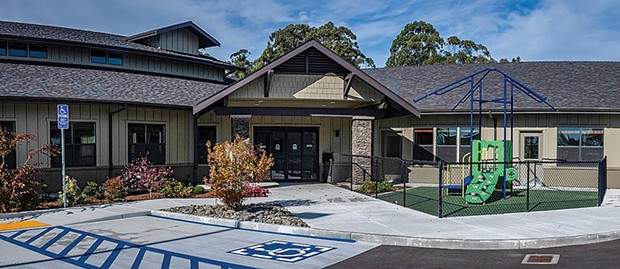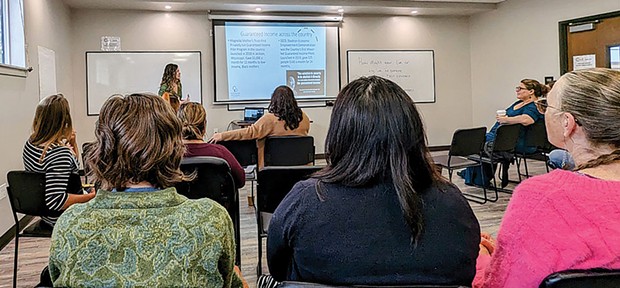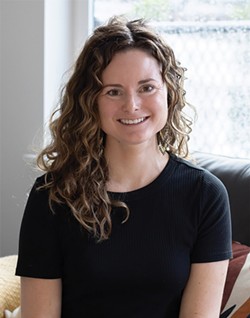Guaranteed Income
McKinleyville pilot program aims to change lives with dignity
By Kimberly Wear [email protected] @kimberly_wear[
{
"name": "Top Stories Video Pair",
"insertPoint": "15",
"component": "17087298",
"parentWrapperClass": "fdn-ads-inline-content-block",
"requiredCountToDisplay": "1"
}
]
On Jan. 25, a group of Humboldt County residents participating in a guaranteed income pilot program received their first installment of $920.
Known as the Humboldt Income Program and administered through the McKinleyville Family Resource Center, the monthly payments will continue for a year and a half to those enrolled after meeting certain requirements, including being in their first or second trimester of pregnancy and having an income at 200 percent of the federal poverty level or below.
And, recipients can spend the money anyway they choose — no strings attached.
After confirmation of the initial payment was posted on the HIP interactive communication platform, the reaction from those enrolled was immediate.
"Wow, thank you so much! I'm still in shock 🙏 huge stress relief for my family!"
"Thank you very much, God bless you."
"I got my payment. I literally cried, thank you guys so much, a huge weight has been lifted from my shoulders."
It was a milestone more than a year in the making after the nonprofit — the only applicant located in a rural area of the state to be selected — received one of seven California Department of Social Services grants to provide the cash payments as part of a poverty reduction effort.
But for the center's Co-Executive Director Robin Baker, the moment was bittersweet.
While the overwhelming majority of those who applied to participate after being referred by community partners including local tribal affiliates, health care clinics and safety net services, were qualified, the state requires all of the programs to have a control group.
That, Baker says, means some applicants are randomly assigned to receive the $920 payments while others are selected to receive $20. Both groups are being asked to participate in a series of voluntary surveys over the course of 18 months to track the impact of the additional funds on people's lives.
Baker says it's rewarding to see the program being so well-embraced by the community and early indications are that participants receiving the full amount are already seeing positive outcomes. But, she says, there are many others living on the financial brink in Humboldt County who also need the assistance, including those who applied — many of whom got their hopes up about being selected — but were placed in the control group.
"It is heartening to know that we've created something that both draws community interest and feels impactful for the folks receiving it," Baker says in an email to the Journal. "At the same time, it is difficult to hold that there are so many people who would benefit from this program who can't yet access it. We've also heard from folks who were not selected for the program about the situations that they are in and how disappointing it was not to be selected.
"We are really excited about the impact of this pilot and we're always assessing what we are doing to understand how it could be improved and how we might do better in the future," she adds.
The state's $25 million foray into funding guaranteed income pilot programs across the state — including nearly $2.4 million to the McKinleyville Family Resource Center — is rooted in the work of former Stockton Mayor Michael Tubbs, a special advisor on economic mobility and opportunity to Gov. Gavin Newsom who made headlines in 2019 after starting one during his tenure leading the Central California city.
A 2021 white paper on the impacts of the Stockton Economic Empowerment Demonstration, or SEED, found that receiving $500 a month for 24 months changed participants' lives in ways large and small, from enabling them to afford a dependable car that led to a better job or weather unexpected expenses to just freeing them of the constant stress of trying to make ends meet.
Others returned to school or were able to start saving for the first time.
Several Stockton parents interviewed said the payments translated into time they didn't have before "to engage with their children in small, but normal rites of passage that generated dignity and quality of life," according to the report, with one recipient describing how they were finally able to "breathe and do homework with them."
Another related how the money allowed them "to say yes to the ice cream instead of no. My kids have always heard no."
The report also found the largest spending category for participants was food, followed by utility bills, auto care and transportation, noting that "less than 1 percent of tracked purchases were for tobacco and alcohol."
"Nearly 4.5 million Californians live below the poverty line — not because of personal failures, but because of policy choices," Tubbs said in a news release from the governor's office. "It's far past time for us to end poverty in our state and the California Guaranteed Income Pilot Program is a critical step in doing that. We saw with the first mayor-led guaranteed income program that I ran in Stockton that guaranteed income is effective at increasing not just financial stability but also mental and physical health, parent-child relationships, and people's ability to strive for goals."
Each of the state-funded pilot programs, including the one in Humboldt, will be evaluated by the Urban Institute, a Washington, D.C., think tank that focuses on economic and social policy research, as well as the University of California at Berkeley, according to Department of Social Services spokesperson Theresa Mier.
"Outcomes that will be studied and evaluated include health and overall well-being, financial stress, employment and education," she said in an email to the Journal. "The final report is currently slated to be completed in 2026."
All seven of the state's pilot programs will be providing guaranteed income payments to pregnant residents and children aging out of foster care, with the aim of assessing "the impact of an economic intervention during key life transitions," Mier said.
Back at the McKinleyville center, which serves as a one-stop shop for connecting Humboldt residents with services ranging from a Food for People pantry to assistance in applying for safety net programs in partnership with local tribes and other agencies, Baker says those established collaborations were integral in the center securing the state grant to start HIP.
During the summer of 2022 application process, many of those same partners — from the county Department of Health and Humans Services and Trinidad Rancheria Tribal Social Services to First Five Humboldt and Changing Tides Family Services and Partnership HealthPlan of California, along with others — wrote letters of support for bringing the program here.
"I think we are a community that cares about each other and we're very invested in each other's well-being," Baker says.
But, she notes, the application was just the first step. The center's acceptance set in motion a six-month window to raise $1.1 million in matching philanthropic funds. That, Baker says, is an essential element of the program because integrating private funding allows the payments to be exempt from counting against other safety net services the recipients might be receiving, including CalFresh — formerly known as food stamps — and Medi-Cal, which would have diminished the intended purpose.
Again, Baker says, the community came through in helping to meet that mark, with Open Door, Humboldt Area Foundation and Footprint Foundation contributing large amounts to join $930,000 coming in from the Guaranteed Income Pooled Fund, which was specifically started to provide matching funds for such programs.
In addition, she says, an individual in Fortuna donated $43,000.
"One thing that I think is really exciting about Humboldt having a Guaranteed Income Pilot is that it gives our community a chance to think together about what stories we want to tell about our region," she says. "We have stories of poverty, of homelessness, or poor health outcomes, etc. We also have incredible stories about land return, cultural revitalization, community art and innovative solutions to community challenges. I hope that HIP illustrates that Humboldt is the kind of place where neighbors are committed to creating communities where every individual and family can have their basic needs met, where we believe in the possibility of a place where every person and family can thrive. That's what I believe we are building together."
While an estimated 12 percent of Californians live in poverty, according to the U.S. Census, Humboldt County's numbers are bleaker, with an estimated 20 percent of households living below the federal poverty line — an annual income of about $15,060 for a single individual and $31,200 for a household of four. The county's median household income, meanwhile, comes in at $53,000 compared to $84,000 statewide.
In 2022, an average of 17,500 Humboldt County households, encompassing 27,000 individuals or one in five county residents, received CalFresh benefits, according to the California Department of Socials Services. To qualify, a family of four had to make less than $39,000 before taxes, while a single individual's income threshold is just under $19,000.
As of late January, a diverse cross section of 99 people from across the county were enrolled in the HIP, with another 67 placed in the $20 per month control group, leaving 51 and 33 spots, respectively, open in each of the categories. Enrollment, which began in December on a referral-only basis, will remain open until May or all slots are filled, according to the program's information page.
Along with the HIP being the only rural area in California to be selected to set up a pilot program, Baker says the local effort differs from others in the state in that it uses a referral system to enroll participants, helping build a level of trust between the program and those applying.
One of the issues the Stockton program found was some potential recipients were skeptical of the offer to apply that came in the mail, believing if it's too good to be true it probably is and dismissing the invitation as a scam.
Still, Baker says, probably "some people aren't going to believe it until (the payment) hits their bank account."
Another difference in the local program is that the McKinleyville center worked to exempt tribal members from having their HIP funds count against their eligibility for the Temporary Assistance for Needy Families programs administered by local tribes. (Baker notes other state programs later followed this approach.)
While the center can help link people with an assortment of resources, she says, those predominantly come with restrictions and allow little or no individual choice.
Baker says she hopes to see more programs like the HIP offered because she adamantly believes individuals are experts in their own lives and best equipped to decide what they need.
"It's so exciting to be leading a program that comes from that space," she says.
Those who work first-hand with clients selected to participate say the first payment has already made a difference.
Isabella Wotherspoon, a perinatal case manager for Open Door Community Health Centers and a referring provider for the HIP, says many mothers in the demographic she serves are "already considered an at-risk and vulnerable population, medically speaking."
"Many things can, and do, complicate pregnancies, and the additional barriers presented by financial resource strain are certainly a glaring contributor to poor maternal health outcomes, throughout a patient's pregnancy and into the postpartum period," she says in an email.
Being able to access an additional $920 without having their other benefits cut, she says, "is a truly progressive, and unfortunately rare, gift."
"This benefit has in some cases doubled, or even tripled, the monthly income for my clients, and has assisted them with garnering permanent, stable housing, ensured they have financial flexibility to take unpaid leave off work to attend their OB provider check-in appointments, assisted them with garnering new/improved transportation and extended unpaid family leave to ensure intensive child rearing/bonding," Wotherspoon writes.
"In one short month, I have seen, first-hand, the improvements in my clients' overall mental health and well-being," she adds. "Words cannot fully convey my gratitude to the McKinleyville Family Resource Center for heralding such an empathetic and integral resource to some of our community's most vulnerable and at-risk population."
Theressa Green, an obstetrics care coordinator with United Indian Health Services, one of the McKinleyville center's partners, says she's seen similar outcomes, noting that her "clients have found the referral process very easy to complete."
"We have one client that is a recipient of the monthly income and she stated, 'This is a life changer for me right now,'" Green says in an email. "One of our clients stated that if she were to receive the money, she would be able to pay for childcare so she can return to work. Another stated the money would allow her to afford childcare so she can start taking classes at (College of the Redwoods)."
"Most of our clients are lower income," she adds, "some with unstable living situations and this income can make a huge difference for them and their families."
In contrast to some of the other anti-poverty efforts the McKinleyville center helps administer, Baker says she sees guaranteed income programs like the HIP as a blueprint for changing people's lives in an empowering way.
"For me," she says, "it's about dignity, autonomy and trusting people."
Kimberly Wear (she/her) is the digital editor at the Journal. Reach her at (707) 442-1400, extension 323, or [email protected].
more from the author
-
Dust to Dust
The green burial movement looks to set down roots in Humboldt County
- Apr 11, 2024
-
Our Last Best Chance
- Apr 11, 2024
-
Judge Rules Arcata Can't Put Earth Flag on Top
- Apr 5, 2024
- More »
Latest in News
Readers also liked…
-
Through Mark Larson's Lens
A local photographer's favorite images of 2022 in Humboldt
- Jan 5, 2023
-
'To Celebrate Our Sovereignty'
Yurok Tribe to host gathering honoring 'ultimate river warrior' on the anniversary of the U.S. Supreme Court ruling that changed everything
- Jun 8, 2023


































